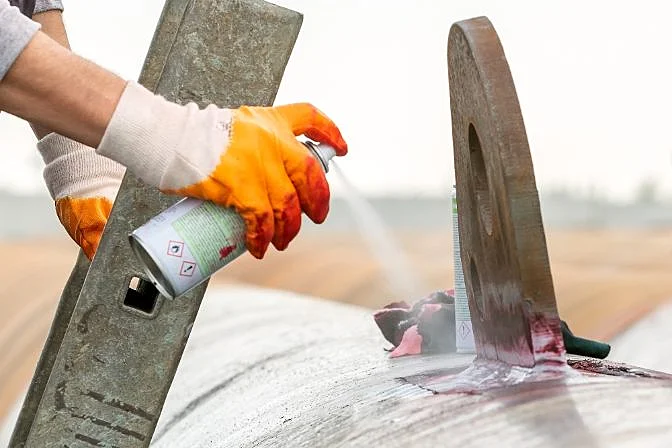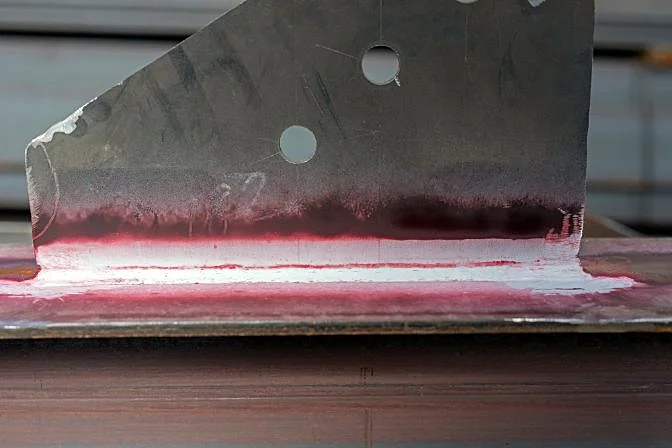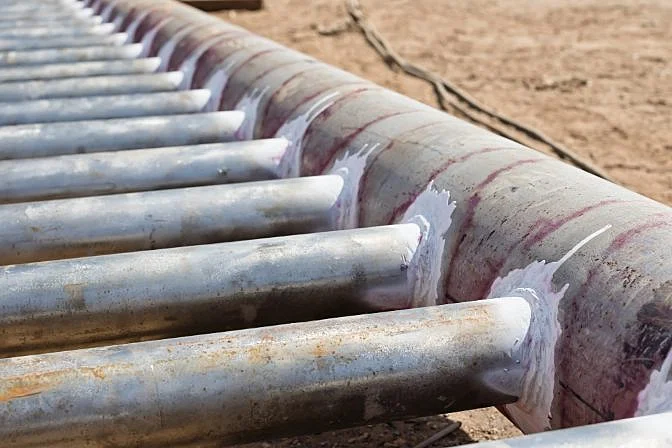What Is Dye Penetrant Testing?
Dye penetrant refers to a dye that is applied by inspectors during dye penetrant inspections. This inspection method involves applying a dye or liquid to a surface to identify potential defects. Often referred to as liquid penetrant or liquid dye penetrant, this technique is widely used across various industries for detecting surface flaws.
Additionally, dye penetrant testing is also commonly known as dye penetrant inspection (DPI), liquid penetrant inspection (LPI), liquid dye penetrant testing, liquid penetrant testing (LPT), or simply penetrant testing (PT). In this guide, we'll refer to it as dye penetrant or liquid dye penetrant interchangeably.
Dye penetrant testing is a popular non-destructive testing (NDT) method. It allows inspectors to detect surface defects without causing any permanent damage to the object being tested. For more information on NDT methods, check out this comprehensive guide.

Understanding Dye Penetrant Testing
Inspectors utilize liquid dye penetrant testing to find cracks or other surface defects on assets and materials. After applying the dye penetrant, inspectors use a chalk-like developer to draw out the liquid, revealing any material defects present on the surface.
This testing procedure relies on the principle of capillary action, which explains how fluids penetrate cracks or discontinuities on a material's surface. Liquid dye penetrant testing is commonly employed for non-porous assets made of ceramics, plastics, and metals. These materials include welds, castings, forgings, plates, bars, and pipes. Inspectors use dye penetrant to detect issues such as leaks, joint flaws, fractures, porosity, cracks (including fatigue cracks, hairline cracks, and grinding or quenching cracks), and incomplete fusion.
Dye penetrant inspections originated in the railroad industry in the early 20th century, utilizing the oil and whiting method. This involved cleaning a surface with an oil solvent and applying chalk or another "whiting" material. The whiting would absorb oil from existing cracks, making them visible for identification and repair. Other industries soon adopted the liquid dye penetrant inspection method, eventually incorporating dyes to enhance crack visibility.

Advantages and Disadvantages of Dye Penetrant Examination
Penetrant testing is a widely used NDT method due to its affordability and relative ease of learning. However, these are just two of its many advantages. Below is a detailed list of the pros and cons of dye penetrant testing:
Pros:
- Simple to execute, even for complex surfaces or shapes.
- Affordable—no costly cameras or equipment are necessary for DPI.
- Capable of inspecting large areas quickly.
- Defects identified by this method can be seen visually on the surface and provide insight into the defect's dimensions.
- Flexible in terms of material—it can be used on ferrous/non-ferrous, conductive/non-conductive, and magnetic/non-magnetic materials.
Cons:
- Limited to detecting only surface cracks or those "open" to the surface.
- Porous materials cannot be inspected using dye penetrant.
- Surfaces containing paint, oil, dirt, rust, or similar obstructions cannot be inspected with dye penetrant.
- Direct access to the material is required.
- The inspection process has multiple steps, each of which can affect the quality of the results.
- Cleaning is necessary both before and after the inspection (preparation before application and removal afterward).
- Chemicals are involved, requiring inspectors to follow protocols for handling and disposal, and these chemicals may produce hazardous or flammable fumes.
Steps in a Dye Penetrant Test
In dye penetrant testing, inspectors generally follow these six steps:
Step 1: Surface Cleaning
First, inspectors clean the surface to be tested to ensure it is free of dirt or other foreign substances. This ensures that any defects are exposed rather than hidden beneath debris. Cleaning methods can range from less invasive techniques like vapor degreasing or solvent use to more intensive approaches like grinding or wire brushing.
Step 2: Applying the Dye Penetrant
Inspectors apply the specially formulated penetrant using spray or brush application. After application, they wait for a "dwell period" of five to twenty minutes to allow the penetrant to dry. The exact duration should be indicated on the penetrant's label.
Step 3: Removing Excess Penetrant and Applying Remover
Inspectors remove any excess penetrant with a dry cloth. Following this, they apply a remover to the surface and dry it with a fresh, clean, dry cloth.
Step 4: Applying Developer
After cleaning and removing the dye penetrant, inspectors apply a white developer to the surface. The developer draws the penetrant from the flaws or cracks, making them visible.
Step 5: Inspection
At this stage, cracks and other defects become visible either to the naked eye or under white or ultraviolet light, depending on the type of penetrant used. Visible dye penetrants allow defects to be seen under normal lighting conditions, while fluorescent penetrants require UV light in low ambient lighting for visibility.
Step 6: Cleaning the Surface
After completing the inspection, inspectors typically clean the surface to restore it to its original condition.

Selecting Penetrants, Removers, and Developers
Inspectors have several choices when selecting penetrants, removers, and developers for the penetrant testing process. Each option can be paired with any other (except dry powder, which cannot be used with color contrast penetrant), enabling inspectors to customize combinations to meet their specific needs.
Penetrant Options:
- Color contrast
- Fluorescent
- Combination (both color contrast and fluorescent)
Remover Options:
- Solvent
- Post-emulsifiable remover
- Water-soluble
- Water-suspendable
Developer Options:
- Dry powder
- Aqueous
- Non-aqueous developer
Inspectors base their selections on factors such as the type of surface, its size, and its complexity.
Dye Penetrant Standards and Codes
While dye penetrant testing is often used for informational purposes where specific codes or standards are not required, it is also frequently used for code-based inspections.
For these inspections, inspectors must adhere to specific procedures, including following a written protocol and ensuring that the tester is certified by the relevant standards body. Here are some widely used dye penetrant testing codes:
ASTM (American Society for Testing and Materials)
- ASTM E 165: Standard Practice for Liquid Penetrant Examination for General Industry
- ASTM E 1417: Standard Practice for Liquid Penetrant Testing
- ASME BPVC, Section V, Article 6: Liquid Penetrant Examination
- ASME BPVC, Section V, Article 24: Standard Test Method for Liquid Penetrant Examination SE-165 (identical to ASTM E-165)
ISO (International Standards Organization)
- ISO 3452-1: Non-destructive testing - Penetrant testing - Part 1. General principles
- ISO 3452-2: Non-destructive testing - Penetrant testing - Part 2: Testing of penetrant materials
- ISO 3452-3: Non-destructive testing - Penetrant testing - Part 3: Reference test blocks
- ISO 3452-4: Non-destructive testing - Penetrant testing - Part 4: Equipment
- ISO 3452-5: Non-destructive testing - Penetrant testing - Part 5: Penetrant testing at temperatures higher than 50°C
- ISO 3452-6: Non-destructive testing - Penetrant testing - Part 6: Penetrant testing at temperatures lower than 10°C
- ISO 3059: Non-destructive testing - Penetrant testing and magnetic particle testing - Viewing conditions
- ISO 12706: Non-destructive testing - Penetrant testing - Vocabulary
- ISO 23277: Non-destructive testing of welds - Penetrant testing of welds - Acceptance levels
CEN (European Committee for Standardization)
- EN 1371-1: Founding - Liquid penetrant inspection - Part 1: Sand, gravity die and low pressure die castings
- EN 1371-2: Founding - Liquid penetrant inspection - Part 2: Investment castings
- EN 10228-2: Non-destructive testing of steel forgings - Part 2: Penetrant testing
- EN 10246-11: Non-destructive testing of steel tubes - Part 11: Liquid penetrant testing of seamless and welded steel tubes for the detection of surface imperfections
For further reading on penetrant testing, visit the websites of internationally recognized standards organizations such as ASME, ASTM, NBIC, and ISO.
Coated Wire Rope,Color Steel Wire Rope,Coating Steel Wire Rope,Coated Inox Steel Cable
JIANGSU RUIJIN SLING CO.,LTD. , https://www.cnsteelcable.com